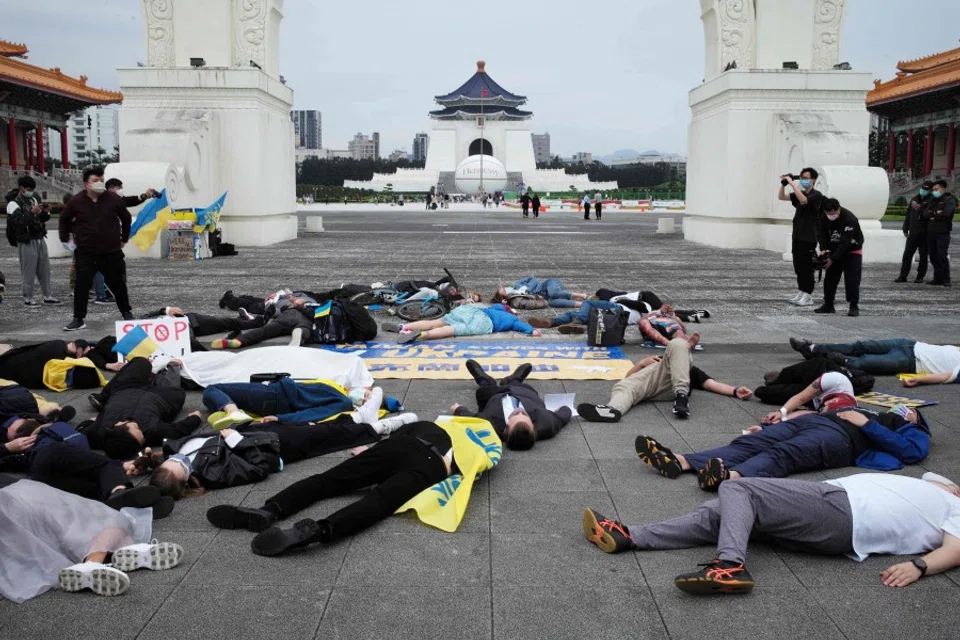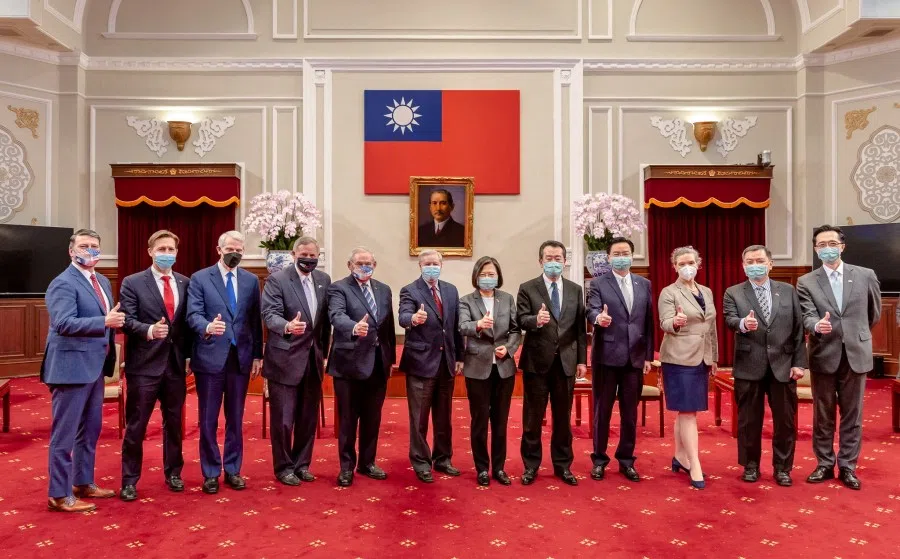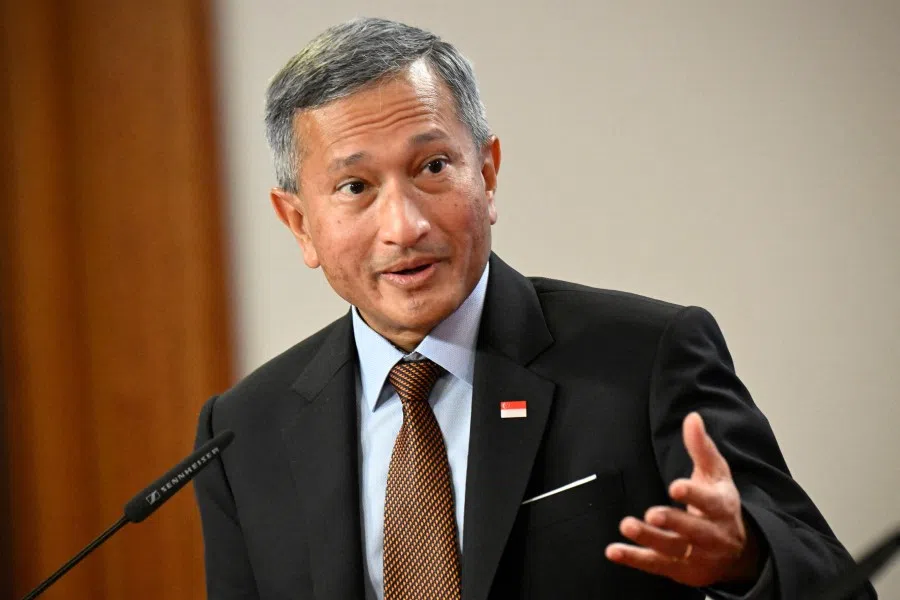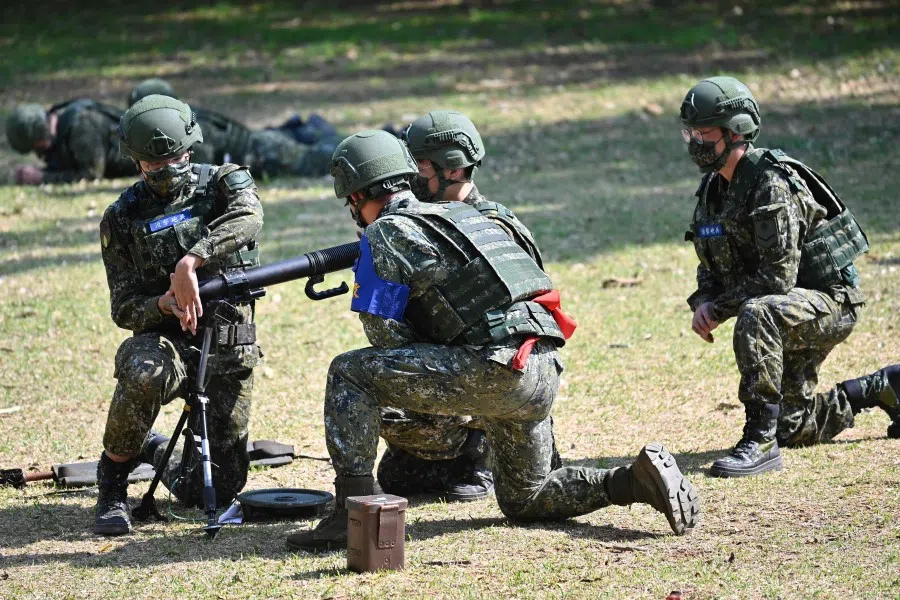'Ukraine today, Taiwan tomorrow': Should Southeast Asia worry?
Russia's invasion of Ukraine is a stark reminder of the possibility that the fate of Taiwan may be eventually decided by military force. For Southeast Asian states, the clear preference is to avoid becoming embroiled in a cross-strait conflict, though it may come at the expense of their own principles and security. Eventually, Southeast Asian states should realise that they cannot treat the threat of a cross-strait war as a distant problem as they stand to face unavoidable political, economic and security risks if the worst-case scenario unfolds.

The unresolved dispute between China and Taiwan is the most significant potential flashpoint in Asia.
Russia's invasion of Ukraine in February is a stark reminder that state-sponsored use of military force is not a relic of the past, and the international community lacks the cohesion to deter a regional hegemon committed to using its military to achieve political objectives.
Taiwan's social media resonated with the phrase, "Ukraine Today, Taiwan Tomorrow", highlighting the public's increased insecurity and sense of inevitability that China will feel compelled to use force against Taiwan. An open conflict over Taiwan would likely involve the US and Japan, and would likely also spill over into Southeast Asia.
While the majority of US-China bilateral differences and tensions are unlikely to escalate to the point of military confrontation, Taiwan is the principal exception. The senior-most officials of the Chinese Communist Party (CCP) consistently tell their American counterparts that Washington's support for Taiwan is the most sensitive issue in the US-China relationship.
China insists that the cross-strait dispute is an internal matter that third countries should not interfere in. Southeast Asian states generally respect this position, limiting their engagement with Taiwan to economic matters while avoiding political and security entanglements.
Should cross-strait tensions increase to the point of conflict, the consequences for Southeast Asia would be dire, raising the question of how Southeast Asian countries would be impacted and whether individual states, or the Association of Southeast Asian Nations (ASEAN), would actively respond to prevent tensions from rising to the point of military conflict.
...the threat to use military force against Taiwan is specifically intended to deter Taiwan from pursuing a path towards independence, not provoke a war with America which neither side wants
The biggest tinderbox
The risk that a military conflict breaks out over Taiwan is not an abstract or remote possibility. Beijing sees Taiwan as an intrinsic part of the People's Republic of China (PRC), characterised by its "one China" principle. Achieving unification is a fundamental goal of the CCP, a political commitment it has made over generations of leaders since Mao Zedong, linking unification to the CCP's very legitimacy and justification for its continued rule.
Senior CCP leaders frequently state that the use of military force to achieve unification if peaceful measures fail is reasonable and rational due to the importance of the objective. The legal justification to use military force is enshrined in Article 8 of China's anti-secession law passed in 2005.
China's ambassador to the US, Qin Gang, reminded his American audience in a recent interview: "China will not commit to giving up non-peaceful means for reunification... the Taiwan issue is the biggest tinderbox between China and the United States."
The ambassador made clear, however, that the threat to use military force against Taiwan is specifically intended to deter Taiwan from pursuing a path towards independence, not provoke a war with America which neither side wants.

PRC pressure against Taiwan has ratcheted up under President Xi Jinping, including rhetoric justifying the use of force to resolve the cross-strait dispute. Xi's own 2013 statement that the Taiwan issue "should not be passed down generation after generation" created a sense of urgency as well. Unification is an inherent element of Xi's "China dream" of national rejuvenation, making Taiwan a measure of his success and political legacy, and raising the stakes for resolution on his terms, peaceful or otherwise.
The threat to deploy the People's Liberation Army (PLA) to attack Taiwan to force unification is made credible not only by the PLA's increasing capabilities achieved by its two-decade long modernisation and expansion, but by regular demonstrations of force, including PLA Air Force missions into Taiwan's Air Defence Identification Zone (ADIZ), naval transits of China's aircraft carriers off Taiwan's east and west coasts (which Taiwan officials describe as "encirclement missions"), and recurring military exercises simulating amphibious exercises and attacks on Taiwan.
Japan and Australia have notably changed their assessments of the risk and consequences of a cross-strait conflict.
Taiwan's government, led by President Tsai Ing-wen, has taken a cautious and pragmatic approach to managing cross-strait relations, seeking to balance the competing interests and desires of Taiwan's public and Beijing's political objectives. She has also sought to placate the US by not succumbing to populism and not openly supporting independence, which would antagonise Beijing and alienate Washington.
Taiwan public opinion polls consistently make clear that there is little to no support among the population to unify with the PRC, with the majority of Taiwanese supporting the current status quo, despite a latent desire for independence, which becomes the dominant preference if the threat of military force is removed from consideration.
This indicates the success of Beijing's military pressure campaign and threat to use force as an effective deterrent against Taiwan moving towards independence. Beijing's uncompromising position on unification by any means, and the failure of economic and political inducements to stimulate Taiwanese popular support for unification, create an uneasy status quo that is increasingly shaped by the growth of China's military capabilities and the role of third countries underwriting Taiwan's security.
Japan and Australia becoming third parties
The longstanding US policy objective is to provide Taiwan with the necessary support - diplomatic and military - to enable Taipei to negotiate a peaceful resolution with Beijing, or as the White House's recently released Indo-Pacific strategy states: "...to ensure an environment in which Taiwan's future is determined peacefully in accordance with the wishes and best interests of Taiwan's people." US economic and military support for Taiwan since the 1950s has effectively underwritten Taiwan's sovereignty and maintained the current stasis in pursuit of that goal.
As China's military power grows, deterring Beijing from using force against Taiwan becomes more challenging, and requires increased commitments commensurate with China's increasing threats and capabilities.

The US is not the only third country concerned about the risk that cross-strait relations could deteriorate should deterrence fail and Beijing opts for a military solution to the Taiwan issue. Japan and Australia have notably changed their assessments of the risk and consequences of a cross-strait conflict.
Australia's decision to acquire long-range weapons including tomahawk missiles and nuclear-powered submarines as part of the 2021 Australia-UK-US (AUKUS) agreement indicates its determination to project power as far as Northeast Asia as part of an effort to deter China from using force.
Japan has stepped up its acquisition of long-range weapons including a hypersonic weapons programme, and signed an agreement with Australia to deepen military cooperation and enable Australia to operate more seamlessly with Japan in Northeast Asia.
Southeast Asian states have thus far opted to avoid becoming embroiled in cross-strait issues, preferring instead to limit engagement to economic relations with Taiwan on an unofficial basis, while sidestepping political choices that would antagonise Beijing.
Japan's rationale for these moves was made clear by former Prime Minister Shinzo Abe who stated, "A Taiwan emergency is a Japanese emergency, and therefore an emergency for the Japan-US alliance." The fact that Japan and Australia as third parties have taken such significant rhetorical and tangible steps to deter Beijing from using force against Taiwan indicates their changed assessment of the probability and impact of a cross-strait conflict.
Southeast Asian states on the other hand have not made a similar transition, indicating a different perception of the risks and potential benefits of contributing to deterrence efforts to prevent a cross-strait conflict.
Implications for Southeast Asia
Southeast Asian states have thus far opted to avoid becoming embroiled in cross-strait issues, preferring instead to limit engagement to economic relations with Taiwan on an unofficial basis, while sidestepping political choices that would antagonise Beijing.
Singapore is a notable exception, having a military-to-military relationship with Taiwan that is a vestige of Singapore's use of Taiwan's military facilities prior to the establishment of Singapore-PRC diplomatic ties in 1992.
However, Singapore does not provide any security guarantees to Taiwan, nor does it have a law similar to the US's Taiwan Relations Act. Singapore is the most articulate of the Southeast Asian states regarding concerns about US-China tensions, including the Taiwan issue at its core.
Prime Minister Lee Hsien Loong stated succinctly at the 2015 Shangri-La Dialogue, "no country wants to choose sides between the US and China", underscoring the risks that Singapore sees in rising US-China competition.
Not choosing sides is popular concept, but it does not take into account Singapore's own values and agency. In some circumstances, Singapore will make policies based on their own interest, regardless of how it aligns with either PRC or US preferences.
Singapore's response to Russia's invasion of Ukraine is an example where Singapore chose to impose sanctions and denounce the invasion, despite China supporting Russia. Explaining his country's rationale for opposition at the United Nations (UN), Singapore's foreign minister, Vivian Balakrishnan, underscored Singapore's commitment to the "fundamental norms of international law and the UN Charter that prohibit the use of force and acts of aggression against another sovereign State", which is considered "an existential issue" for the country.
However, while Singapore's values reflect its interest in protecting sovereignty and the rights of small states from predation by larger ones, opposing China would be a very difficult decision in the event of China's invasion of Taiwan.

Unlike China, Russia is geographically distant, and inconsequential economically to Singapore and other Southeast Asian states. Imposing sanctions against China would be costly for Singapore, both politically and economically. China is the largest trading partner to every country in the region. Wide-ranging sanctions of the type imposed on Russia would be devastating to Southeast Asian economies should they be imposed on China.
Southeast Asian states are unlikely to follow Japan and Australia's lead by hard balancing with the US and its allies, but regional diplomatic responses are not inconceivable.
Singaporean public opinion is quite favourable towards China, fuelled by local Chinese-language media which echoes PRC narratives even when it is at odds with government policy such as Singapore's position on the invasion of Ukraine. Should Singapore's government strongly oppose a PRC invasion of Taiwan, public opinion would likely run against it.
Furthermore, Taiwan lacks diplomatic relations with any Southeast Asian state or status in the UN, making its sovereignty ambiguous. This lack of recognition gives Singapore and Southeast Asian states a justification for not choosing sides in a cross-strait conflict, should they seek to avoid the considerable political and economic costs of directly opposing and sanctioning China.
While avoidance may be the preferred policy option for most Southeast Asian states should cross-strait tensions rise, there may come a point when China's pressure on Taiwan, particularly military pressure, elevates risks to Southeast Asian interests, prompting some countries to contribute to efforts in their own way to discourage China from using force. Southeast Asian states are unlikely to follow Japan and Australia's lead by hard balancing with the US and its allies, but regional diplomatic responses are not inconceivable.
Singapore hosting the Ma Ying-jeou-Xi Jinping summit in 2015 is an example of the role individual Southeast Asian states can play in leveraging their influence and bilateral channels with Beijing to express their opposition to the use of force and encourage diplomatic solutions.
Although ASEAN is not designed to confront external security threats or deter aggression beyond its member states, in the event of a crisis, its member states could be expected to express the lowest-common denominator position which would likely call on all parties to act with restraint, without naming the sides.
Should China lose hope in the prospect of peaceful unification and decide to use military force to compel Taiwan to unify, there will undoubtedly be negative political, economic and security consequences for Southeast Asia.
Security implications
For ASEAN as an organisation, a cross-strait military conflict undermines the most fundamental premise of ASEAN itself - the peaceful resolution of disputes without resort to violence, enshrined in Article 13 of the 1976 Treaty of Amity and Cooperation in Southeast Asia (TAC). While ASEAN and its member states will be understandably reluctant to choose sides in a conflict, maintaining its credibility would necessitate at the very least the renunciation of the use of force.
The security impacts to Southeast Asia of a military conflict on its periphery cannot be understated. The Philippines' security situation would be most directly affected should a conflict break out.
While it is likely that ASEAN would call on all sides to exercise self-restraint and avoid violence without singling out China, Beijing's reliance on military coercion and the threat to use force against Taiwan should heighten strategic anxieties among ASEAN member states, particularly those with their own territorial disputes with China. It would be disingenuous and delusional for those states to ignore the precedent set by a cross-strait conflict initiated by Beijing since they would eventually also be subject to Chinese military coercion over their own disputes.
Granted, it may be politically convenient to "other" Taiwan and claim Taipei's dispute with Beijing is an internal matter and therefore different from the South China Sea (SCS) disputes. However, should the PLA attack Taiwan, the future prospect of peaceful settlement of disputes with China would be greatly diminished, leaving Southeast Asian claimant states in a significantly disadvantageous position in the SCS.

The security impacts to Southeast Asia of a military conflict on its periphery cannot be understated. The Philippines' security situation would be most directly affected should a conflict break out. The Bashi channel is a strategically important choke point for navy vessels, especially the PLA Navy's submarines based in southern China, making it certain that belligerents would seek to dominate the space in and around the channel. The Philippines' territorial air and sea space would undoubtedly be directly affected by a conflict, but it is conceivable that security consequences would extend further.
US and Chinese naval and aviation forces are unlikely to restrict hostilities to a defined box around Taiwan. Both the US Navy and PLA Navy would have incentives to use SCS choke points to target naval vessels transiting from the Middle East to enter the primary theatre around Taiwan. US and PLA air forces would be operating throughout the region as well. The Taiwan theatre would undoubtedly encompass Southeast Asia.
It would be difficult, if not impossible, to deter an emboldened China, having successfully used military force to take over Taiwan, from repeating the feat, regardless whether China's adversary is a US ally or not.
How a cross-strait conflict ends would impact Southeast Asia as well. A successful conflict to unify Taiwan would undermine US credibility, potentially leading to a reduced US military presence in the region, or the US inability to deter China from using force to settle other territorial disputes.
Countries that enable a sustained US military presence in the region would be confronted by an empowered, hegemonic Beijing willing to more actively pressure smaller states to reject the US military or curtail its activities in the region. Military success in Taiwan could lead to China establishing a sphere of influence over Southeast Asia, greatly diminishing the autonomy and sovereignty of Southeast Asian states.
It would be difficult, if not impossible, to deter an emboldened China, having successfully used military force to take over Taiwan, from repeating the feat, regardless of whether China's adversary is a US ally or not. Furthermore, China's suzerainty over the SCS and its sea lanes would impact the security and economies of all Southeast Asian states, as well as Northeast Asian states dependent on SCS sea lanes.
It is worth noting that the SCS is not the only route between the Indian Ocean and Northeast Asia, but it is the shortest, and therefore the cheapest and most efficient. Longer transit routes increase shipping costs - a key input that would contribute to the rising costs of virtually all commodities and finished goods in the region.
Should China mobilise the PLA to unify Taiwan and fail, it is difficult to find a silver lining in that cloud either. Political turmoil in Beijing is a potential outcome. A frustrated CCP and PLA unable to achieve their primary political objective through the use of force might seek validation and redemption through a military campaign against a less-capable adversary in a territorial dispute with Beijing, potentially in the SCS.
Economic and humanitarian concerns
Taiwan's economy is large, ranked 23rd in the world by GDP, behind only Indonesia in Southeast Asia. Its industries are integrated into regional supply chains, and Taiwan is a major source of foreign direct investment in Southeast Asia.
A conflict would not only disrupt supply chains and economic activity on Taiwan itself, but Taiwan-invested companies in China would likely curtail their activities, including payments to mainland workers, further disrupting Southeast Asian and global supply chains relying on integrated manufacturing bases in both China and Taiwan.
More importantly, economic activity throughout China would be disrupted by a massive military mobilisation effort. Commercial aviation and maritime trade would be impacted, with planes and ships re-routed away from the conflict zone and wartime risk insurance increased, while hoarding and uncertainty would also drive up costs, driving inflation.
Economic impacts would be broad - not just the cost of disrupted technology supply chains centred on Taiwan and its highly prized integrated circuit industry, but the regional costs of food, energy, commodities and consumer goods as well. Possible US and allied sanctions against China would magnify the economic damage caused by military mobilisation and the conflict itself.

Another concern is over labour mobility between Taiwan and Southeast Asia, which is both a political and economic issue. According to Taiwan's Ministry of Labour, there were over 718,000 workers from Southeast Asia resident in Taiwan before the Covid-19 pandemic, primarily from Vietnam, Indonesia, and the Philippines.
As Taiwan's economy grows, its working-age population shrinks, and the government reforms its immigration policy, that number is expected to increase. Taiwan is therefore an important source of remittances to Southeast Asia. In the event of a cross-strait conflict, large numbers of citizens from Southeast Asian states resident in Taiwan would face substantial threats to their personal security and safety.
ASEAN's own conception of a cooperative and inclusive Indo-Pacific, as well as its centrality, is challenged by the use of force to settle disputes on its periphery.
ASEAN's agency
With clear political, economic and security consequences arising from a cross-strait conflict, Southeast Asian interests undoubtedly lie in maintaining the current peaceful status quo, but the question is how much political capital would Southeast Asian states be willing to spend to maintain it.
The peaceful resolution of disputes should be a bottom line for Southeast Asian states, just as it is a principle for ASEAN. Regional interests extend beyond maintaining credible pathways to peaceful resolution of SCS disputes, too. ASEAN's own conception of a cooperative and inclusive Indo-Pacific, as well as its centrality, is challenged by the use of force to settle disputes on its periphery.
Southeast Asia stands at a crossroads, benefiting from its strategically important location across vital sea lanes, as well as the intrinsic advantages of each country's industrious population and complementary economies. Globalisation and connectivity that have made Southeast Asia so central to Asia's prosperity also make it vulnerable to conflict-induced global disruptions.
ASEAN and Southeast Asian states had little incentive to directly intervene and contribute to efforts to dissuade Vladimir Putin, particularly when the US and Europe were so actively engaged prior to Russia's invasion. Ukraine is more distant than Taiwan, affording Southeast Asian states the luxury of standing on the sidelines.
However, a military conflict in Europe will undoubtedly have an impact on Southeast Asia, whether it is economic disruption and inflationary pressures, or the humanitarian consequences of violent incidents such as the downing of Malaysian Airlines Flight 17 in 2014 over eastern Ukraine. Taiwan, however, is contiguous to Southeast Asia, so the consequences will undoubtedly be greater.
In 1956 at the outset of the Cold War, US Secretary of State John Foster Dulles declared that neutralism is an "immoral and short-sighted conception", as he sought to rally allies behind America in its competition with the Soviet Union. President Dwight D. Eisenhower, however, pragmatically walked back that assertion, recognising India and other countries' commitment to non-alignment while noting that the US itself had once remained neutral and avoided entanglement in European conflicts.
For Southeast Asian states, the clear preference is to avoid becoming embroiled in a cross-strait conflict, but eventually, the question is not how they can stay neutral or not choose sides in a conflict involving the three largest economies on the planet. The issue is whether they can continue to assess that a war on their doorstep is a distant problem that they must stay out of at all costs, or whether they will use their agency to contribute to efforts to deter China from using force, impressing upon Beijing that peaceful settlement of disputes with all parties, including Taiwan, is a core Southeast Asian interest that they are ready to defend.
This article was first published as ISEAS Perspective 2022/39 ""Ukraine Today, Taiwan Tomorrow": Should Southeast Asia Worry?"

![[Big read] Paying for pleasure: Chinese women indulge in handsome male hosts](https://cassette.sphdigital.com.sg/image/thinkchina/c2cf352c4d2ed7e9531e3525a2bd965a52dc4e85ccc026bc16515baab02389ab)


![[Big read] How UOB’s Wee Ee Cheong masters the long game](https://cassette.sphdigital.com.sg/image/thinkchina/1da0b19a41e4358790304b9f3e83f9596de84096a490ca05b36f58134ae9e8f1)
